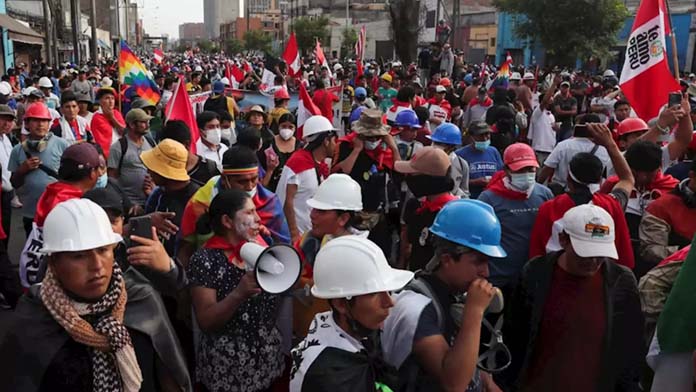Peru has been rocked by weeks of strikes and protests following the impeachment and arrest of left-wing president Pedro Castillo in December.
Protesters have burnt government buildings, blocked highways and occupied airports. They are demanding the resignation of newly appointed president, Dina Boluarte, quick general elections, a new constitution and Castillo’s release.
Castillo is a former teachers’ union leader who came to national prominence during the 2017 teachers’ strike that lasted nearly three months. The son of illiterate peasants and a member of the moderate socialist party Free Peru, he contested the 2021 presidential election as an outsider but—much to the annoyance of Peru’s political and business elites—narrowly won.
Castillo focused on the massive divide between the rich and the poor and promised there would be “no more poor people in a rich country”.
His campaign struck a chord with Peru’s workers, who have suffered from 30 years of neoliberal economic reforms that have stripped away social support while allowing the wealthiest 1 per cent to enrich themselves.
Every year billionaires from Peru are listed in Forbes magazine’s list of world billionaires. Meanwhile, according to the United Nations, half the country lacks regular access to sufficient nutrition. During the COVID crisis, Peru had the highest death toll per capita in the world and its underfunded healthcare system was severely exposed.
Destabilisation
Peru’s business elite and their backers in the conservative-dominated congress never accepted Castillo’s election victory.
His opponent, Keiko Fujimori, the daughter of former autocratic president Alberto Fujimori (in jail for abusing human rights and embezzlement), immediately made unsubstantiated claims of electoral fraud and began leading marches demanding some results be annulled.
Meanwhile a letter signed by nearly 100 retired military officers called on the military not to recognise Castillo’s victory. In the end, congress used the 1993 constitution, written under the authoritarian rule of Alberto Fujimori, to impeach Castillo.
This constitution gives congress the power to impeach presidents on the vague grounds of “moral incapacity”.
Appeasement
Rather than mobilise his supporters, Castillo’s strategy for dealing with the campaign of destabilisation was to move to the right and appease the establishment—following the dead end of left reformist parties elsewhere.
After a flight of capital out of the country following his victory on the first round of presidential voting, Castillo responded by assuring jittery investors that he would not be nationalising companies, that he would honour the rule of law and that “there is no Chavismo here”—referring to Hugo Chavez, who ruled Venezuela for 14 years until his death in 2013.
Castillo sacked his own prime minister, Guido Bellido, after Bellido threatened the gas company Camisea with nationalisation during negotiations over domestic prices and taxes. He also appointed “business-friendly” former central banker, Kurt Burneo, as minister of economy and finance.
But Castillo’s efforts to appease the right failed, so he resorted to a constitutional manoeuvre to try to stop the impeachment process. He used emergency powers to dissolve congress and to rule by decree.
His manoeuvre was ruled illegal by the constitutional court. Congress impeached him hours later and he is currently facing charges of “rebellion” and “conspiracy”.
Dina Boluarte, who was on Castillo’s presidential ticket and his vice-president, became the new president. She is considered a safer pair of hands by Peru’s elite, having been expelled from the Free Peru party after claiming she never embraced its ideology.
Boluarte has responded to the developing protests over Castillo’s removal by declaring a state of emergency that curtailed people’s rights and put the army, which has a record of human rights abuses, onto the streets to support the police.
More than 50 people have been killed by security forces, which human rights organisations accuse of using excessive force and of firing indiscriminately at protesters. Eighteen people were killed and over 100 injured in just one protest in Juliaca in early January.
The state violence, however, is just fuelling the protests and the determination of protesters to bring Boluarte down. She is clearly on the backfoot. Cabinet ministers have resigned and she has asked congress to bring the next election forward and has apologised for the deaths, but she is still refusing to resign.
A poll conducted by the Institute of Peruvian studies found that Boluarte has a disapproval rating of 71 per cent. Congress itself had a disapproval rating of 88 per cent.
As Solidarity goes to press, the grassroots-driven protests are continuing. This is the way forward for workers in Peru. If they can force Boluarte to resign, it will be a tremendous victory.
By Mark Gillespie




